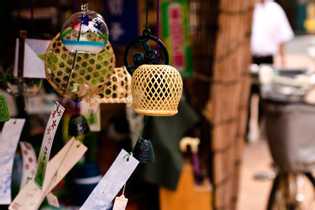風鈴(ふうりん) - Furin (a wind-bell)
A wind-bell is called a furin in Japan. A furin is a small bell made of metal or porcelain that hangs and rings in the wind. These wind-bells give poetic charm to the Japanese summers. In the sultry summer season people hang wind-bells from the edge of their eaves. Then people enjoy the cool when the furins swing and ring in the breeze. There is also a fancy strip of paper called tanzaku that hangs from the bell’s clapper. When a breeze comes, the tanzaku swings and causes the clapper to hit the bell. This results in the bell’s ringing.
風鈴は、金属製または陶製の釣り鐘型の小さな鈴で、日本の夏の風物詩の一つです。日本の人々は、蒸し暑い夏が来ると風鈴を軒先に吊り下げ、風に揺れる音を聞いて涼を感じ、楽しみます。釣り鐘の舌に吊るされた短冊が風に揺れ、舌が釣り鐘に当たって鳴る仕組みになっています。
There are haiku written on the tanzaku. Haiku are poems written in 17 syllables, which must consist of three phrases of five, seven, and five syllables. Writers must express their feelings and a sense of the season in these few syllables. Every haiku must include a word or phrase about the season, which is called a kigo. This is done to express a sense of the season. The haiku written on the tanzaku make the wind-bell more tasteful. Thus, wind-bells are closely associated with haiku and the expression wind-bells can be used as a kigo for the summer.
短冊には五・七・五の音節から成る俳句を書きます。俳句はわずか17音の中に季節感と作者の心情を詠み込んだ定型詩で、必ず季語を入れることになっています。短冊に書かれた俳句によって、さらに風情が増します。このように俳句と風鈴は密接な関係があり、風鈴は俳句の夏の季語になっています。
